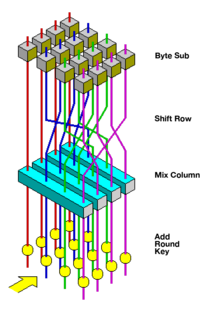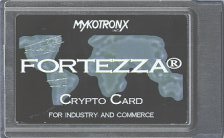
The Advanced Encryption Standard (AES), also known by its original name Rijndael, is a specification for the encryption of electronic data established by the U.S. National Institute of Standards and Technology (NIST) in 2001.
In cryptography, key size, key length, or key space refer to the number of bits in a key used by a cryptographic algorithm.

In cryptography, encryption is the process of encoding information. This process converts the original representation of the information, known as plaintext, into an alternative form known as ciphertext. Ideally, only authorized parties can decipher a ciphertext back to plaintext and access the original information. Encryption does not itself prevent interference but denies the intelligible content to a would-be interceptor.

Communications security is the discipline of preventing unauthorized interceptors from accessing telecommunications in an intelligible form, while still delivering content to the intended recipients.
The U.S. National Security Agency (NSA) ranks cryptographic products or algorithms by a certification called product types. Product types are defined in the National Information Assurance Glossary which defines Type 1, 2, 3, and 4 products.

The Clipper chip was a chipset that was developed and promoted by the United States National Security Agency (NSA) as an encryption device that secured "voice and data messages" with a built-in backdoor that was intended to "allow Federal, State, and local law enforcement officials the ability to decode intercepted voice and data transmissions." It was intended to be adopted by telecommunications companies for voice transmission. Introduced in 1993, it was entirely defunct by 1996.

STU-III is a family of secure telephones introduced in 1987 by the NSA for use by the United States government, its contractors, and its allies. STU-III desk units look much like typical office telephones, plug into a standard telephone wall jack and can make calls to any ordinary phone user. When a call is placed to another STU-III unit that is properly set up, one caller can ask the other to initiate secure transmission. They then press a button on their telephones and, after a 15-second delay, their call is encrypted to prevent eavesdropping. There are portable and militarized versions and most STU-IIIs contained an internal modem and RS-232 port for data and fax transmission. Vendors were AT&T, RCA and Motorola.

Fortezza is an information security system that uses the Fortezza Crypto Card, a PC Card-based security token. It was developed for the U.S. government's Clipper chip project and has been used by the U.S. Government in various applications.

Export of cryptographic technology and devices from the United States was severely restricted by U.S. law until 1992. The law gradually became eased until around 2000, but some restrictions still remain today.
The National Security Agency took over responsibility for all U.S. Government encryption systems when it was formed in 1952. The technical details of most NSA-approved systems are still classified, but much more about its early systems have become known and its most modern systems share at least some features with commercial products.
VINSON is a family of voice encryption devices used by U.S. and allied military and law enforcement, based on the NSA's classified Suite A SAVILLE encryption algorithm and 16 kbit/s CVSD audio compression. It replaces the Vietnam War-era NESTOR (KY-8/KY-28|28/KY-38|38) family.
SAVILLE is a classified NSA Type 1 encryption algorithm, developed in the late 1960s, jointly by the Government Communications Headquarters (GCHQ) in the UK and the National Security Agency (NSA) in the US. It is used broadly, often for voice encryption, and implemented in many encryption devices.

This glossary lists types of keys as the term is used in cryptography, as opposed to door locks. Terms that are primarily used by the U.S. National Security Agency are marked (NSA). For classification of keys according to their usage see cryptographic key types.
NSA Suite B Cryptography was a set of cryptographic algorithms promulgated by the National Security Agency as part of its Cryptographic Modernization Program. It was to serve as an interoperable cryptographic base for both unclassified information and most classified information.
FASCINATOR is a series of Type 1 encryption modules designed in the late-1980s to be installed in Motorola digital-capable voice radios. These radios were originally built to accept a DES-based encryption module that was not approved by NSA for classified communications. The FASCINATOR modules replaced the DES units and can be used for classified conversations at all levels when used with appropriately classified keys. FASCINATOR operates at 12 kbit/s for encryption and decryption. It is not compatible with DES-based voice systems.

Cryptography, or cryptology, is the practice and study of techniques for secure communication in the presence of adversarial behavior. More generally, cryptography is about constructing and analyzing protocols that prevent third parties or the public from reading private messages; various aspects in information security such as data confidentiality, data integrity, authentication, and non-repudiation are central to modern cryptography. Modern cryptography exists at the intersection of the disciplines of mathematics, computer science, electrical engineering, communication science, and physics. Applications of cryptography include electronic commerce, chip-based payment cards, digital currencies, computer passwords, and military communications.
The Advanced Narrowband Digital Voice Terminal (ANDVT) is a secure voice terminal for low bandwidth secure voice communications throughout the U.S. Department of Defense. Devices in the ANDVT family include the AN/USC-43 Tactical Terminal (TACTERM), the KY-99A Miniaturized Terminal (MINTERM), and the KY-100 Airborne Terminal (AIRTERM). ANDVT uses LPC-10 voice compression.

Bullrun is a clandestine, highly classified program to crack encryption of online communications and data, which is run by the United States National Security Agency (NSA). The British Government Communications Headquarters (GCHQ) has a similar program codenamed Edgehill. According to the Bullrun classification guide published by The Guardian, the program uses multiple methods including computer network exploitation, interdiction, industry relationships, collaboration with other intelligence community entities, and advanced mathematical techniques.

The Crypto Wars is an unofficial name for the attempts of the United States (US) and allied governments to limit the public's and foreign nations' access to cryptography strong enough to thwart decryption by national intelligence agencies, especially the National Security Agency (NSA).

NESTOR was a family of compatible, tactical, wideband secure voice systems developed by the U.S. National Security Agency and widely deployed during the Vietnam War through the late Cold War period of the 1980s. NESTOR consists of three systems. The KY-8 was used in vehicular and afloat applications; the KY-28 was the airborne version; and the KY-38 was the portable or man-pack model. About 30,000 NESTOR equipments were produced prior to their replacement by the VINSON secure voice family.











